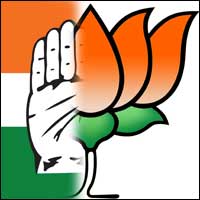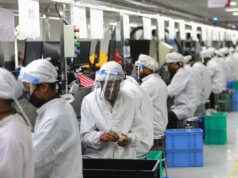With Lok Sabha election dates already announced, UPA II government will soon become a history. While the UPA II has come under lot of criticism for its non-functioning, worsening governance quality and eroding economy and the project investment, we have endeavoured to critically examine, in terms of hard statistics, the economy performance under UPAII period of five years 2009-10 to 2013-14, juxtaposing the feat against the earlier five years 2005-06 to 2008-09 under UPA I and 1999-00 to 2003-04 under the National Democratic alliance (NDA).
Income side of Economy
Helped largely by 8 per cent rise during 1999-00 and a similar measure in 2003-04, the economy growth rate over the five-year period as measured by GDP at factor cost was around 5.9 percent average per year under National Democratic Alliance (NDA). The good economy show in 2003-04 gave rise to “India Shining” concept to the nation.
An exhilarating 9+ per cent average economy growth for three consecutive years 2005-06 to 2007-08 under UPAI that yielded 8.4 per cent average rise over the five-years period, merited a new perception “India on the Rise” even as the terminal year 2008-09 had seen the growth rate fall to 6.7 per cent due to global meltdown.
The first two years 2009-10 and 2010-11 under UPAII started off on an encouraging note with growth rate picking up to 8.6 percent and then to 9.3 per cent during 2010-11 indicating the country’s resilience; marveling the world at the speed of recovery from global meltdown-caused rot. However, domestic factors largely governance deficit, non-functioning Parliament, heightened glaze on grafts, fears of corruption charges among bureaucrats, etc brought down the growth rate to 6.2 per cent in 2011-12 and to less than 5 per cent consistently in the subsequent two years, a steady low that has not occurred for over a quarter century. The speed of decay in the rate in just three years time turned the economy from a resilient economy driven by domestic strength to a fumbling economy sadly due to domestic blocks. By the way, notwithstanding a lacking economy feat in particularly 2012-13 and 2013-14, the average growth over the five years period worked out to around 6.7 per cent, falling below the robust 8.4 per cent under UPAI, but surpassing 5.9 per cent under NDA regime.
The share of agriculture, fishing & forestry in GDP at factor cost has continued its secular decline. It declined from 24 per cent in 1998-99 to 20 per cent in 2003-04 under NDA; from 20 per cent in 2003-04 to 16 per cent in 2008-09 under UPA I and from 16 per cent in 2008-09 to 14 per cent in 2013-14 under UPA II. By and large, the farm sector has remained uncared for with its erratic growth rates influenced by rainfall.
Contrary to popular perceptions, the share of manufacturing in GDP at factor cost remained at 15-16 per cent throughout the 15 years period of NDA and UPAI and UPAII, notwithstanding thousands of crore of project investment pouring into the sector
The share of electricity, gas & water has got stuck at 2 per cent; the phenomenon reflects more the static power prices, which has bled power distribution companies.
The share of mining sector the base material infrastructure for manufacturing and electricity has slightly gone down more or less steadily from 3 per cent to 2 per cent over 15 years period. Price realization for the minerals has been administered and uneconomic which has resulted in bountiful financial rewards to downstream industries. Investment in the sector has had to reckon with graft cases/allegations, policy confusion, delays in environment clearances, opposition from land oustees and political meddling.
The share of construction, a proxy indicator for incomes of persons engaged in project investment as also the volume of project investment, increased only marginally from 6.5 per cent in 1998-99 to 7.1 per cent under NDA; a little faster from 7.1 per cent to 8 per cent under UPAI, but declined to 7.4 per cent under UPAII, with fall concentrated during 2012-13 and 2013-14 due to falling investment rate.
The share of commercial services that exclude government administration & defence increased from 42 per cent to 46 per cent under NDA; 46 per cent to 50 per cent under UPAI and from 50 per cent to 54 per cent under UPAII.
In services, the most remarkable change in share occurred in banking & insurance, which expanded marginally from 5.6 per cent to 5.7 per cent under NDA, but got stepped up to 7.2 per cent under UPAI and rose further to 9 per cent under UPAII. The share of wholesale, retail trade went up from 13 per cent to 14 per cent under NDA; from 14 per cent to 15 per cent under UPAII and from 15 per cent to 16 per cent under UPAII.
The share of transport, communication & storage rose from 6 per cent to 8 per cent under NDA, from 8 per cent to 9.4 per cent under UPAI and from 9.4 per cent to 10+ per cent under UPAII. Bulk of the increase in share has occurred under communication wit some rise reported in road, sea and air transport. The share of government-owned Railways has remained at one per cent both under NDA and UPA regimes.
The share of government administration and defence, which constitutes important law & order infrastructure ranged 5.9-6.7 per cent under NDA, 5.1-5.9 per cent under UPAI and 5.7-6.2 per cent under UPAII (till 2012-13).The major focus under NDA, UPAI and UPAII has been containment of this expenditure.
Consumption & Investment
The share of final consumption expenditure in GDPmp went down from 76 per cent in 1998-99 to 72 per cent in 2003-04 under NDA, from 72 per cent to 71 per cent under UPA I and remained at around this level under UPAII. The share of government final consumption expenditure has remained at 10-11 per cent over the past 15 years’ period. Private final consumption increased at 5 per cent average over NDA; 9 per cent average over UPA and 6 per cent average during UPAII.
The investment rate as measured by gross fixed capital investment to GDPmp inched up from 24 per cent to 25 per cent under NDA. The share escalated rather rapidly to 33 per cent under UPAI reflecting hectic investment pace, but declined slightly to 32.5 per cent under UPAII. The fall in investment rate was largely during 2012-13 and 2013-14 due to investment slack, which was reflected in stagnation in project investment in these two years due to adverse factors impinging capex of private corporates as also PSUs. GFCF increased at 7 per cent average per year during NDA; 19 per cent average during UPA and helped by good show in the first three years around 6 per cent during UPAII.
Export, Import, Capital Inflow
The share of export of goods & services in GDPmp rose from 10 per cent to 15 per cent under NDA, from 15 per cent to 24 per cent under UPAII and from 24 per cent to only 25-26 percent under UPAII. Thus, the UPAI period proved to be highly rewarding for exporters in the country. Software, petroleum products and engineering goods were among the bright spots in export buoyancy.
The share of import of goods & services in GDPmp increased from 15 per cent to 17 per cent under NDA, speeded from 17 per cent to 31 per cent under UPAI, but the pace slowed to 34 per cent by 2013-14 under UPAII. Bulk imports comprising crude and petroleum products, agricultural commodities, fertilizers rose faster than non-bulk imports that included capital goods, gold & silver, Pearl Precious Semi-Precious Stones, etc.
Increase in valuables like gold, silver ornaments took away 2-3 per cent of GDPmp uniformly over the 15 years period.
Foreign Capital
Contraction in the trade deficit, coupled with a rise in net invisibles receipts, resulted in a reduction in current account deficit (CAD), or import of foreign capital to bridge the gap between domestic capital investment and domestic savings to $31.1 billion (2.3 per cent of GDP) during April-December 2013 from $69.8 billion (a recent years’ high of 5.2 per cent of GDP) in April-December of 2012. Barring the initial years of 2001-02 to 2003-04, the country has remained net importer of foreign capital, which reached a peak of $88 billion during 2012-13, with recent quarters witnessing some improvement in this measure.
FDI into the country increased more rapidly under UPAI, relative to that under NDA, to scale to around $42 billion during 2008-09, but the subsequent years under UPAII have seen the this capital inflow decline to around to $27 billion during 2012-13. The first three quarters of the ongoing fiscal has seen FDI into the country of $21 billion ($19.8 billion). The overseas investment by the country fell to only $327 million during April-December 2013 from $5.7 billion a year ago. The share of overseas investment to inward investment rose from 15 per cent in March 2002 to over 55 per cent by September 2013.
Inflation
WPI-based inflation remained at around 3.5 percent average during 2001-02 and 2002-03, though the second year 2000-01 under NDA had seen the escalation to 7.2 per cent from 3.3 per cent in the first year. The fifth year saw the inflation rise to 5.5 per cent, with non-food articles, fuel & power and manufactured products largely influencing the WPI inflation rate.
The WPI inflation rate remained range bound between 4.4-6.5 per cent during the first four years of UPAI, even as in the terminal year 2008-09, the rate spiked to 8.1 per cent due to widespread price increase in primary articles, fuel & power and prices and to some extent manufactured products.
Barring the first year 2009-10, which saw 3.8 per cent overall rate notwithstanding 15 per cent rise in food product prices, the WPI inflation has remained high in the later years 2010-11 to 2013-14 due to high food prices, as also fuel & power rates (even as the overall rate has eased a bit in the closing months of 2013-14).
Reflecting subdued demand from project investment, project cost index as measured by ERIL Index of Cost of Project Inputs showed only 1.4 per cent increase till January 2014, against 2.3 per cent in the similar period a year ago and 5.3 per cent two years back.
|
Macro Indicators (Y-o-Y % increase)
|
||||||
| Year |
GDP
|
Agriculture
|
Industry
|
Services
|
GFCF
|
WPI
|
| NDA Period | ||||||
| 1999-00 |
8.0
|
2.7
|
6.0
|
12.1
|
7.9
|
3.3
|
| 2000-01 |
4.1
|
0.0
|
6.0
|
5.1
|
-1.4
|
7.2
|
| 2001-02 |
5.4
|
6.0
|
2.6
|
6.6
|
15.3
|
3.6
|
| 2002-03 |
3.9
|
-6.6
|
7.2
|
6.7
|
-0.4
|
3.4
|
| 2003-04 |
8.0
|
9.0
|
7.3
|
7.9
|
10.6
|
5.5
|
| UPA I Period | ||||||
| 2004-05 |
7.1
|
0.2
|
9.8
|
8.3
|
24.0
|
6.5
|
| 2005-06 |
9.5
|
5.1
|
9.7
|
10.9
|
16.2
|
4.4
|
| 2006-07 |
9.6
|
4.2
|
12.2
|
10.1
|
13.8
|
6.6
|
| 2007-08 |
9.3
|
5.8
|
9.7
|
10.3
|
16.2
|
4.7
|
| 2008-09 |
6.7
|
0.1
|
4.4
|
10.0
|
3.5
|
8.1
|
| UPA II Period | ||||||
| 2009-10 |
8.6
|
0.8
|
9.2
|
10.5
|
7.7
|
3.8
|
| 2010-11 |
8.9
|
8.6
|
7.6
|
9.7
|
11.0
|
9.6
|
| 2011-12 |
6.7
|
5.0
|
7.8
|
6.6
|
12.3
|
8.9
|
| 2012-13 |
4.5
|
1.4
|
1.0
|
7.0
|
-0.3
|
7.4
|
| 2013-14 |
4.9
|
4.6
|
0.7
|
6.9
|
0.8
|
5.17*
|
| Till January 2014 | ||||||











